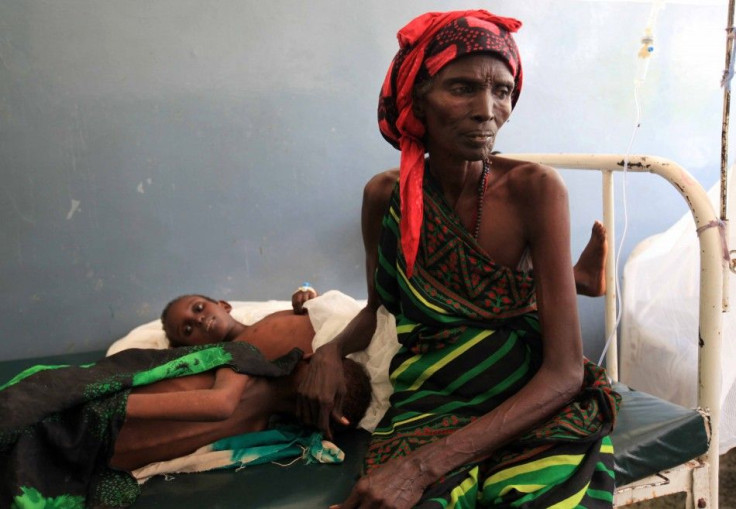The Somalia Famine: 5 Things to Know

The ongoing famine in Somalia is being called the worst humanitarian crisis of a generation. Tens of thousands of people have died from malnutrition in just a few months, while millions more are still in danger. Thousands of Somalis leave their home everyday, hoping to find a better life in over-crowded refugee camps in Kenya and Ethiopia.
This will not be a short crisis, UN Emergency Relief Coordinator Valerie Amos said last month.
But what is behind this humanitarian disaster and how can it be abated? Below are five need-to-know elements of the famine in Somalia.
1. Cause: The chief cause of the crisis in Somalia is a massive and long-lasting drought in East Africa. Agriculture in the Horn -- which comprises Somalia, Ethiopia, Kenya, Djibouti and Eritrea -- has been devastated, harming food production, live stock and economies on both the local and national level.
Yet, the Somali government is largely to blame for the trouble within its borders, much as it is to blame for the spate of piracy in recent years. Since the 1991 fall of the Said Barre regime, there have been many attempts at re-stabilizing the nation, but none have succeeded so far, and many areas of the country are controlled by warlords and rebels, while others are simply lawless.
The collapse of the state... led to one of the worst humanitarian crises in the world today, translating into unacceptable suffering of innocent civilians who see their basic human rights violated every day, the United Nations Refugee Agency said in a statement.
Kenya is facing a similar drought, but government regulation has assured that the country will not slip into famine. Until there is a stable government, there will be turmoil in Somalia.
2. Al-Shabaab: Al-Shabaab, an al-Qaeda backed Islamic militant group, is as much a government in many parts of Somalia as President Sheikh Sharif Ahmed's official government is. Considered a terrorist organization by many Western powers, including the United States, al-Shabaab rules over the famine-stricken states of Bakool and Lower Shabelle, and until recently, they controlled much of Mogadishu.
Al-Shabaab notoriously controls the humanitarian aid that enters certain parts of the country, highjacking food packages and taxing starving citizens. Moreover, because al-Shabaab is an enemy of the United States, the U.S. will not provide any aid to regions under the rebels' control.
We are committed to saving lives in Somalia and we are already working in any area not controlled by al-Shabaab, Donald Steinberg, deputy administrator of USAID, said at a briefing in London. Unfortunately, about 60 percent of people affected are in al-Shabaab territories. We've instructed UNICEF and [World Food Program] that they can use our assistance in any part not under al-Shabaab control.
3. The Figures: Famine is now officially in five Somali states. A famine is a technical term that describes a situation in which child malnutrition is above 30 percent, at least two in 10,000 people die per day, and where there is no access to food and water for some people.
About 3.7 million people in the Horn of Africa suffer from starvation, while about six million more suffer from hunger. A total of 12.4 million people in Somalia alone require immediate assistance, according to the UN Office for the Coordination of Humanitarian Affairs, and the number of people needing lifesaving humanitarian assistance could reach 15 million before the situation begins to turn around. Additionally, nearly 400,000 children are malnourished.
4. Humanitarian Aid: The United Nations has estimated that $2.5 billion needs to be collected right away if Somalia is to be pulled out of famine.
The United States has given about $430 million so far, while a UK government official visited Somalia Thursday with an additional $41 million (making the UK total $90 million). The British people have contributed an additional $80 million.
The Turkish public has raised $115 million, and Prime Minister Recep Erdogan says they will reach their goal of $200 million. The Turkish government has also pledged a significant figure, and with a group of other Muslim nations, the country is giving $350 million to Somalia.
Erdogan visited Mogadishu on Friday, stating that he would like to open an embassy to increase his country's assistance in the region. The Turkish Prime Minister was the first non-African head of state to visit the city in almost 20 years.
5. Solutions: Inertia is the worst thing that could happen to Somalia. If the West ignores or forgets about the crisis, hope for an entire generation and millions of people is lost.
I have read in the last few days a number of articles noting a decrease of interest in the Horn of Africa in the press and in the public. This must not happen. We cannot let a kind of disaster fatigue set in, said UNICEF Executive Director Anthony Lake, at a news conference at UN Headquarters to mark World Humanitarian Day.
The statistics can be mind-numbing, but remember that the data is sons and daughters. The statistics are little boys and little girls, every one of them, said Lake, adding that the situation in Somalia was a human disaster becoming a human catastrophe.
More important than aid is giving Somalia the support to build a productive government on its own. If money is the way to do that, then money there needs to be. But even if this famine can be quelled through humanitarian aid, another disaster will soon follow, unless Somalia can reign in the chaos. There is a reason that, even before famine struck, Somalia generated the most refugees of any country in Africa, and third most of all countries in the world. In essence, it is perpetually in a state of war, and there is no prosperity without there first being peace.
© Copyright IBTimes 2024. All rights reserved.











